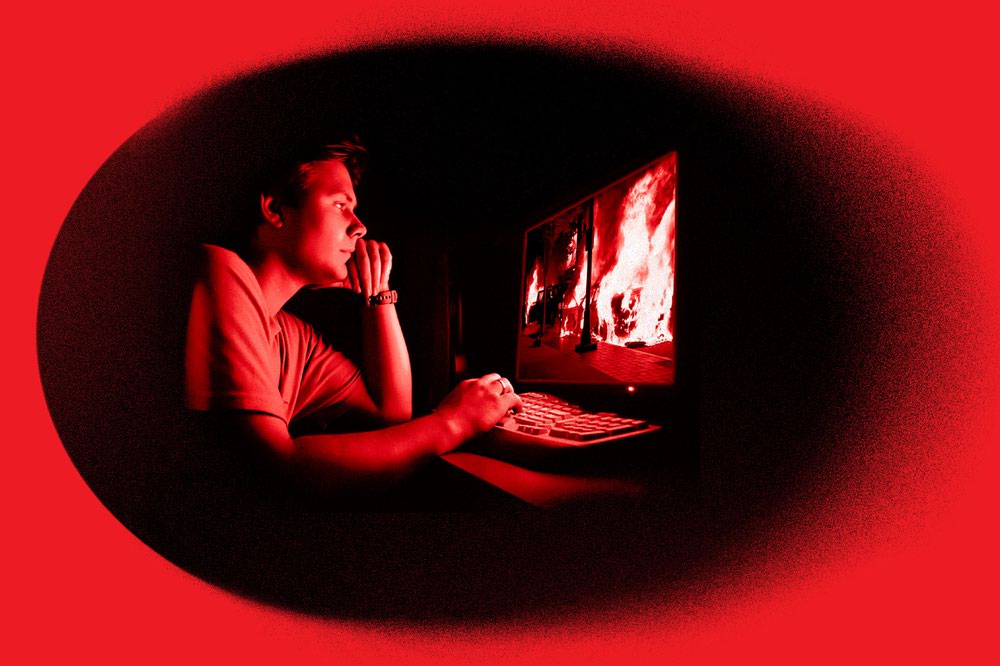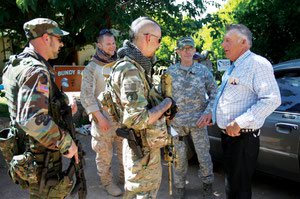Ten years ago this month, Nevada rancher Cliven Bundy and his family hosted a swarm of armed protesters at their ranch in Bunkerville, 80 miles northwest of Las Vegas. The gathering was a sort of Woodstock for anti-government militias that were, in their view, defending the Bundys from the Bureau of Land Management (BLM).
The BLM was attempting to collect $1 million owed in grazing fees, which Bundy had unsuccessfully disputed for more than two decades, by impounding Bundy’s cattle. As the Bundys spewed long rants about their so-called Constitutional rights, they called on militias to come to their aid. Right-wing media and online forums caught on and eventually, protesters and heavily armed militia groups like the then-relatively unknown Oath Keepers (whose leaders and members were convicted of federal crimes for their role in the January 6, 2021 attack on the U.S. Capitol) flocked to the ranch.
After tense, armed confrontations, on April 12, 2014, the BLM called off the roundup. But that wasn’t enough for the Bundys. They marched with hundreds of protesters to the pens where the BLM was keeping the impounded cows, pointed their guns at federal agents and demanded that the cattle be released. After the standoff, which easily could have turned into a shootout, federal agents stood down and released the cattle. (Cliven, Ryan and Ammon Bundy later were jailed but were cleared of conspiracy charges in 2018 after a judge declared a mistrial in their case.)
The event was seen as a major victory and rallying moment for anti-government militias, who have grown stronger, especially during the pandemic. In many cases it was the first time leaders in these movements met face-to-face. The Bundy standoff also was part of a nationwide narrative of violent extremism that has continued to grow, and has festered with the widespread use of social media and online platforms.
Brian Hughes, co-founder and associate director with American University’s Polarization and Extremism Research and Innovation Lab (PERIL), says the Bundy standoff is just one instance where people have been radicalized to act violently in order to affirm or live out their ideologies. More recently, social media and other online platforms have helped facilitate Stop the Steal protests, the January 6 attack on the Capitol, armed men storming the Michigan statehouse and plots and threats against officials, and have encouraged a climate of violent online threats by the far right against their fellow Americans.
“We talk about mobilizing concepts where these extremist groups, using online communication technology, were able to get those radicalized rank and files to act in a certain way around certain issues,” Hughes says.
“COVID-19 was a tremendous moment for radicalizing content and radicalizing vulnerabilities … the sense that something had been taken away, and people needed someone to blame. And extremist groups understood this. And I think that without the specific intersection of conditions, January 6 would not have happened the way that it did.”
The pathway to an armed standoff with federal agents may seem narrow. However, extremists like the Bundys and their circle tend to take advantage of certain “grievances” or social-emotional “vulnerabilities” when recruiting members to join their calls to action, Hughes adds. In 2014, the Bundys were able to speak to peoples’ different grievances with the federal government and unite them under one banner.
“The expression of extremism and political violence is different in different regions and across different cultures. But there’s very little difference between the underlying risk factors that seem to lead people down those pathways to radicalization,” Hughes says. “Grievance and other social and emotional vulnerabilities like trauma or precarity can lead a person in a lot of different pathological directions. [And] a person needs to encounter radicalizing material or radicalizing social groups in order for those grievances to be translated into political extremism.”
UNLV professor of sociology Robert Futrell, who specializes in social movements and has written two books about the rise of white supremacy in the U.S., says growth in extremist networks is rooted in a very human process: people just seeking a sense of belonging.
“Everybody’s seeking some meaning for their lives. And extremists tend to find it in those networks,” Futrell says. “There might have been some sort of trauma they attribute to some group or some entity. … They [then] find a group that cares about them and speaks to some of their fears, maybe what they think are threats, and the ideology helps to explain what was previously unexplainable.”
The goal is recruitment. And that is where the internet and social media come in.
“Before the internet, a person would have to be very unlucky to encounter enough radicalizing material, or individuals, to turn their grievances into a radicalization pathway,” Hughes says. “You had to sort of become enmeshed in that social circle in order to become radicalized that way. … Nowadays, when you go online, you can’t avoid propaganda. White supremacist and other extremist propaganda is fed to you, whether you like it or not.”
DOWN THE RABBIT HOLE
The Bundys subscribe to sovereign citizen ideology, or the belief that self-named “sovereign citizens” are not under the jurisdiction of the federal government and therefore exempt from U.S. law, hence the refusal to pay grazing fees that every other rancher had to pay to the BLM. The radical viewpoint has gained even broader appeal in recent years, according to the Southern Poverty Law Center, which tracks extremists and hate groups.
“Sovereign citizen groups, which are under the umbrella of anti-government groups, saw a diversifying of the people joining those groups. So, a growing appeal to younger, female and more affluent members,” says Lydia Bates, program manager of partnerships with the Southern Poverty Law Center’s Intelligence Project.
That growing appeal could be the result of a concerted effort among extremists to change their branding to attract broader swaths of people, a trend that Futrell has noticed among white supremacists. He points to the deadly Unite the Right rally in Charlottesville in 2017.
“People were aghast at the Charlottesville Unite the Right weekend in part because many of the people there … with the tiki torches, didn’t look like white supremacists in this stereotypical way,” Futrell says. “And so, … they’re shifting the rhetoric; they’re covering their tattoos; they’re talking about infiltrating institutions. They’re talking about a concerted effort to mask true intentions, to no longer look like the hooded Klansmen or belligerent, in-your-face stereotypical neo-Nazi skinhead, and to do things differently in order to gain power.”
Bates gives the example of the Asatru Folk Assembly, a white supremacist group that is active in Nevada according to the Southern Poverty Law Center.
“They fit under our hate group umbrella and on an ideology that’s called Neo-Völkish, [which] is basically taking Norse paganism imagery and mythology and making it racist. Asatru as an actual Icelandic religion is not inherently racist. … But the Asatru Folk Assembly and other Neo-Völkish groups like it have taken that and made it a whites-only group,” Bates says.
She adds that radicalizing content may not start out as overtly radical, but can escalate. Different talking points can lead into radical ideologies like the great replacement theory, which is an anti-immigrant and racist belief in a worldwide plot to diminish the influence of white people.
“When you’re exposed to some types of extremist content, it might seem relatively innocuous; it might not seem that crazy. It might be some Norse pagan symbolism, which isn’t inherently racist. And then they start introducing you to ideas like the great replacement theory or male supremacy talking points.”
The effort to mask radical ideologies online makes radicalization more insidious, as peoples’ curiosity can cause them to stumble into rabbit holes of radical and extremist content. When coupled with the use of “alt-media” platforms where radical and extremist views can be shared more openly, extremists have the means of taking unsuspecting users down a deep rabbit hole, indoctrinating users in their ideologies.
“There’s also a range of what’s now called alt media … more fringe platforms [like] Parler, Discord, Telegram. There’s an ecosystem out there that goes from more private to more public. And as people navigate and step into the various rabbit holes that exist for getting into online extremism, you can pretty easily find your way to those, and sometimes they find you,” Futrell says.
ONLINE EXTREMISM IN THE AGE OF COVID
The Bundys’ rallying cry started in April 2014. Then in 2015, Donald Trump entered the picture. His spewing of Islamophobia and anti-immigrant rhetoric, as well as his appointing of senior advisors like Steve Bannon of the far-right news media outlet Breitbart News Network, signaled to extremists that it was OK to come out.
“White supremacists saw him as an ally, that there was an opportunity to come out of hiding and be more public and put on a stronger face for white supremacy than what they had been able to do before,” Futrell says. “Charlottesville was a perfect example of that, and his response that there were ‘good people on both sides’—that blew up across the extremist networks as ‘Hey, he’s not against us. We’ve got an ally!’ … His Proud Boys statement ‘Stand back and stand by’ becomes super important to racist networks.”
So there was this environment for white supremacists and conspiracy theories like QAnon to thrive. And then came COVID. With social distancing and isolation, people spent vastly more time online and some were exposed to far less dissenting opinions, creating echo chambers—another fertile ground for radicalization.
“People were joining these online communities, where there’s no dissenting opinions; there’s no differing worldviews [and] people are just saying the same thing over and over again, and cementing each other’s worldviews,” Bates says. “That was a really big issue in terms of people being exposed to extreme content and becoming more susceptible to radicalizing.”
Shutdowns in March 2020, then virtual school and work, mass furloughs, layoffs and uncertainty created precarity and vulnerabilities nationwide. During that time, recruitment for extremist demonstrations was rife. The Southern Poverty Law Center saw the spread of disinformation, especially related to voting and the election, as the year played out.
It also saw more concerted efforts among extremist groups to take action in person.
Rachel Goldwasser, senior research analyst with the Southern Poverty Law Center, says the organization saw a proliferation of Boogaloo Boys in Nevada, a far-right, anti-government extremist group that says it wants a second civil war and the collapse of society. In Las Vegas, three men alleged to be members of the movement were arrested in May 2020 and charged with conspiracy to cause destruction during Black Lives Matter rallies, as well as the possession of Molotov cocktails. According to court documents, the group plotted to bomb a power substation or federal property and incite chaos and a possible riot.
“There were quite a lot of Boogaloos that were there, especially in 2020. … And I think this idea of armed resistance appeals to them, which is something that could have been in some way grown from Bundy ranch,” Goldwasser says. “Most far right movements have cross-pollination in their membership numbers. So people got into QAnon as adherents and supporters, and then moved into sovereign citizenship, [or] people who were brand-new anti-vaxxers that moved into the sovereign citizens movement. So groups are also adding people in that way, where they start with one movement and go to believing multiple things that are extreme.”
The pandemic created the perfect conditions for the cross pollination of extremist ideas and concerted actions. There were also ample opportunities to convince people of radical worldviews and pull them into less mainstream platforms like Parler, which was essential in plotting and carrying out the January 6 attack on the Capitol.
“Online extremism, specifically [inviting] people to in-person [events], is what sort of brought on January 6,” Goldwasser says. “Unfortunately, it’s the online element that was sort of the catalyst—people being able to spread information, especially conspiracy theories related to the election, like lightning around the internet, and then also being able to coordinate events related to conspiracy theories and other ideological beliefs that move people to physical action.”
MOVING FORWARD
The Bundy standoff, Trump, COVID, January 6—experts draw a line between these events. The question is, what’s next?
If last year’s data is any indicator, the Southern Poverty Law Center saw increases in white nationalist activity, male supremacy groups and anti-semitic incidents in 2023. Just in March, dozens of neo-Nazis marched through downtown Nashville.
The Secure Community Network tracks threats and acts of violence against the Jewish community across the U.S. CEO Michael Masters says such demonstrations need to be taken seriously. That’s one of the first steps in addressing violent extremism.
“When the individuals in Charlottesville were saying ‘Jews will not replace us’ and when individuals are carrying the flags of a genocidal regime … I think we should listen to them and take them seriously, and make sure we are leveraging the tools that we have … to prevent that type of hate and violence from being nurtured in our society,” Masters says.
That couldn’t be more important in an election year, when groups like Secure Community Network and the Southern Poverty Law Center continue seeing an uptick in extremism.
“One way that we see a lot of this continuing is through groups like Moms for Liberty. They’re very much fanning the flames of these conspiracy theories about anything that has to do with medicine, vaccines. They’re really going for the book bans [and] really trying to actively limit young people’s access to information, and making sure that disinformation is able to flourish,” Bates says.
“There’s also concerted efforts to spread voting disinformation … about how you vote, who can vote, where you can vote. … I think that’s absolutely something we’ll see a lot more of as November gets closer.”
She adds that hate groups currently have an “intense focus” on certain communities, including LGBTQ and immigrants.
“We saw a lot of targeting of Pride events, drag events. And a lot of that was done by this intersection of anti-LGBTQ and white nationalist groups,” Bates says. “In 2023, there was and continues to be a broad adoption of anti-immigrant rhetoric. And that will absolutely continue as we get closer to the election.”
These ideologies are problematic in themselves. But when attempting to address them, there’s a distinction between First Amendment-protected extremist speech and “violent extremism.”
“Being radicalized or extremist by themselves are not illegal. Frankly, it’s First Amendment-protected activity. People are allowed to be extremists,” Masters says. “I think part of the problem, particularly in the online space, is the explosion of content by individuals with violent, hate-filled beliefs and the seeming normalization of those behaviors.”
And then there are challenges posed by artificial intelligence and state-sponsored disinformation, like deepfakes and bots. Just in January, a deepfake robocall was made to more than 5,000 New Hampshire voters during the state’s Democratic presidential primary, discouraging them from voting, according to NBC News.
“There is a fair amount of evidence to suggest that foreign state and nonstate actors are encouraging, creating and sewing these messages with the ultimate intent of disrupting U.S. society, and undermining the very principles and ideas of our country,” Masters says.
So what tools do we have to combat the rising tide of disinformation and hate? How do we stop the extreme from becoming mainstream? Experts say it’s best to approach the issue from a preventive standpoint.
“When we talk about what government can do, we shouldn’t be talking about what they can ban, and what they can eliminate and legislate away,” Hughes says. “We need to be talking about the positive things that government can be funding. The fact is, education is a huge part of this. The government should be funding programs that improve people’s online safety.”
PERIL has stepped in with resources tailored to specific members of the community. Its website (perilresearch.com/resources/) has free education tools for parents, caregivers, educators, mental health counselors, policymakers, faith leaders and small businesses.
“If people become educated about the ways that propaganda manipulates them, people are better able to recognize it and resist it. And that has been demonstrated as a really effective way to inoculate people against the radicalizing content,” Hughes says.
What to do if you notice someone being radicalized online
How does one become radicalized? Why does it happen, and what are the signs?
UNLV professor of sociology Robert Futrell says the process is based on the human need for connection and purpose.
“People might be more or less susceptible based on various types of variables. But the overall process is one that anyone could understand—searching for friendship, connection, meaning,” Futrell says.
Brian Hughes, co-founder of American University’s Polarization and Extremism Research and Innovation Lab, says the common underlying risk factors for radicalization are grievance and social-emotional vulnerabilities like trauma and precarity.
“If a person is at a major turning point in their life, where their sense of where they belong in the world is suddenly up in the air: that’s a time when a person is a little more vulnerable,” Hughes says.
The signs that someone is starting to be exposed to radicalizing content can be subtle. But the most noticeable one is a “change in affect.”
“So a change in the way a person is expressing themselves emotionally and socially. If a person begins to carry themselves in a more hostile way, in a more combative way, and if that change in affect is connected with changes in the viewpoints that they’re expressing, then that’s a pretty good indicator that they might be going down a pathway of some kind,” Hughes says.
If you believe someone is going down a rabbit hole of radicalization, it can be very difficult to get them out of it, he adds. One approach is to attempt to resolve the person’s vulnerabilities that might make them turn to extremism.
“It’s not really worth it to argue with them. Instead, you should look at why they might be vulnerable. Do they have unaddressed trauma? Do they have professional grievances? Or are they having a crisis of identity? If you can address those underlying issues, very often the symptoms of radicalization will dissipate on their own,” Hughes says.
Lydia Bates, program manager of partnerships with the Southern Poverty Law Center’s Intelligence Project, says we should especially be on the lookout for people going down radicalization pathways as we still deal with the aftermath of COVID.
“People suffered economically during COVID-19 and continue to suffer. So that also impacts radicalization, you’re suffering from that trauma from that uncertainty,” Bates says.
When it comes to counteracting radicalization, “don’t counterpoint their misinformation,” she says, “as that might cause them to double down. Instead, come from a place of curiosity to find out what they’re being exposed to and pull at the strings of that conversation.”
It’s also important to understand you might not be the best person to intervene, Bates says.
“There might be somebody in your community who is more equipped to intervene, who has a closer relationship with the person that you saw posting the disinformation. It could be like a religious leader, who might have an in and an ability to ask them those open-ended questions to get at what is driving their vulnerability to these extremist ideologies, what is making them susceptible.”
Don’t share misinformation or offensive content, even if it’s funny, she adds.
If you believe there is a threat to public safety, it is important to report a tip to the proper authorities. The Southern Nevada Counter Terrorism Center receives and responds to suspicious activity reports in Clark County. The Nevada Threat Analysis Center serves Nevada’s other 16 counties.
To report suspicious activity specifically in Clark County, call 702-828-7777 or submit a tip onsnctc.org.
To report suspicious activity in all other counties in Nevada, call 844-SEE-SAIT (844-733-7248) or email [email protected].
Click HERE to subscribe for free to the Weekly Fix, the digital edition of Las Vegas Weekly! Stay up to date with the latest on Las Vegas concerts, shows, restaurants, bars and more, sent directly to your inbox!







